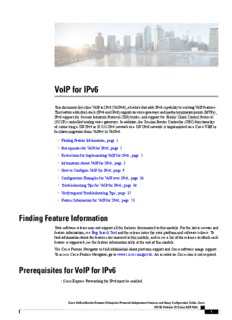
PDF - This Chapter (1.91 MB) PDF
Preview PDF - This Chapter (1.91 MB)
VoIP for IPv6 ThisdocumentdescribesVoIPinIPv6(VoIPv6),afeaturethataddsIPv6capabilitytoexistingVoIPfeatures. Thisfeatureaddsdual-stack(IPv4andIPv6)supportonvoicegatewaysandmediaterminationpoints(MTPs), IPv6supportforSessionInitiationProtocol(SIP)trunks,andsupportforSkinnyClientControlProtocol (SCCP)-controlledanalogvoicegateways.Inaddition,theSessionBorderController(SBC)functionality ofconnectingaSIPIPv4orH.323IPv4networktoaSIPIPv6networkisimplementedonaCiscoUBEto facilitatemigrationfromVoIPv4toVoIPv6. • FindingFeatureInformation, page 1 • PrerequisitesforVoIPforIPv6, page 1 • RestrictionsforImplementingVoIPforIPv6, page 2 • InformationAboutVoIPforIPv6, page 3 • HowtoConfigureVoIPforIPv6, page 9 • ConfigurationExamplesforVoIPoverIPv6, page 36 • TroubleshootingTipsforVoIPforIPv6, page 36 • VerifyingandTroubleshootingTips, page 37 • FeatureInformationforVoIPforIPv6, page 53 Finding Feature Information Yoursoftwarereleasemaynotsupportallthefeaturesdocumentedinthismodule.Forthelatestcaveatsand featureinformation,seeBugSearchToolandthereleasenotesforyourplatformandsoftwarerelease.To findinformationaboutthefeaturesdocumentedinthismodule,andtoseealistofthereleasesinwhicheach featureissupported,seethefeatureinformationtableattheendofthismodule. UseCiscoFeatureNavigatortofindinformationaboutplatformsupportandCiscosoftwareimagesupport. ToaccessCiscoFeatureNavigator,gotowww.cisco.com/go/cfn.AnaccountonCisco.comisnotrequired. Prerequisites for VoIP for IPv6 •CiscoExpressForwardingforIPv6mustbeenabled. Cisco Unified Border Element (Enterprise) Protocol-Independent Features and Setup Configuration Guide, Cisco IOS XE Release 3S (Cisco ASR 1000) 1 VoIP for IPv6 Restrictions for Implementing VoIP for IPv6 •Virtualroutingandforwarding(VRF)isnotsupportedinIPv6calls. CiscoUnifiedBorderElement •CiscoIOSRelease12.4(22)ToralaterreleasemustbeinstalledandrunningonyourCiscoUBE. CiscoUnifiedBorderElement(Enterprise) •CiscoIOSXERelease3.3SoralaterreleasemustbeinstalledandrunningonyourCiscoASR1000 SeriesRouter. Restrictions for Implementing VoIP for IPv6 ThefollowingaretherestrictionsforCiscoUBEfeatures: Media Flow–Through •VideocallflowswithAlternativeNetworkAddressTypes(ANAT)arenotsupported. •WebExcallflowwithANATarenotsupported(CiscoUBEdoesnotsupportANATonVideoand Applicationmediatypes). SDP Pass-Through •SupportsonlyEarlyOffer(EO)–EarlyOffer(EO)andDelayedOffer(DO)–DelayedOffer(DO)call flows. •DelayedOffer–EarlyOffercallflowfallsbacktoDelayedOffer–DelayedOffercallflow. •SupplementaryservicesarenotsupportedonSDPPass-Through. •TranscodingandDTMFinterworkingarenotsupported. Note TheaboveSDPPass–ThroughrestrictionsareapplicableforbothIPv4andIPv6. •SDPPass–Throughdoesnotsupportthedual-stackfunctionality. •ANATcallflowsdoesnotsupportIPv4-to-IPv6andIPv6-to-IPv4Mediainterworking. UDP Checksum •CEFandprocessoptionsarenotsupportedonASR1000seriesrouters. •NoneoptionispartiallysupportedonISR–G2. Media Anti–Trombone •MediaAnti–TromboneisnotenablediftheinitialcallbeforetromboningisinFlow–Around(FA)mode. •MediaAnti–Trombonesupportsonlysymmetricmediaaddresstypeinterworking(IPv4-IPv4orIPv6-IPv6 media)withorwithoutANAT. Cisco Unified Border Element (Enterprise) Protocol-Independent Features and Setup Configuration Guide, Cisco IOS XE Release 3S (Cisco ASR 1000) 2 VoIP for IPv6 Information About VoIP for IPv6 •DoesnotprovidesupportforIPv4-IPv6interworkingcaseswithorwithoutANATbecauseCiscoUBE cannotoperateinFAmodeposttromboning. Information About VoIP for IPv6 SIP Features Supported on IPv6 TheSessionInitiationProtocol(SIP)isanalternativeprotocoldevelopedbytheInternetEngineeringTask Force(IETF)formultimediaconferencingoverIP. TheCiscoSIPfunctionalityenablesCiscoaccessplatformstosignalthesetupofvoiceandmultimediacalls overIPnetworks.SIPfeaturesalsoprovideadvantagesinthefollowingareas: •Protocolextensibility •Systemscalability •Systemscalability •Personalmobilityservices •Interoperabilitywithdifferentvendors ASIPUserAgent(UA)operatesinoneofthefollowingthreemodes: •IPv4-only:CommunicationwithonlyIPv6UAisunavailable. •IPv6-only:CommunicationwithonlyIPv4UAisunavailable. •Dual-stack:CommunicationwithonlyIPv4,onlyIPv6anddual-stackUAsareavailable. Dual-stackSIPUAsuseAlternativeNetworkAddressTransport(ANAT)groupingsemantics: •IncludesbothIPv4andIPv6addressesintheSessionDescriptionProtocol(SDP). •Isautomaticallyenabledindual-stackmode(canbedisabledifrequired). •RequiresmediatobeboundtoaninterfacethathavebothIPv4andIPv6addresses. •DescribedinRFC4091andRFC4092(RFC5888describesgeneralSDPgroupingframework). SIPUAsuse“sdp-anat”optiontagintheRequiredandSupportedSIPheaderfields: •EarlyOffer(EO)INVITEusingANATsemanticsplaces“sdp-anat”intheRequireheader. •DelayedOffer(DO)INVITEplaces“sdp-anat”intheSupportedheader. SIPSignalingandMediaAddressSelection: •SourceaddressforSIPsignalingisselectedbasedonthedestinationsignalingaddresstypeconfigured inthesession-targetoftheoutbounddial-peer: ◦Ifsignalingbindisconfigured,sourceSIPsignalingaddressischosenfromtheboundinterface. ◦Ifsignalingbindisnotconfigured,sourceSIPsignalingaddressischosenbasedonthebestaddress intheUAtoreachthedestinationsignalingaddress. Cisco Unified Border Element (Enterprise) Protocol-Independent Features and Setup Configuration Guide, Cisco IOS XE Release 3S (Cisco ASR 1000) 3 VoIP for IPv6 SIP Voice Gateways in VoIPv6 SDPmayormaynotuseANATsemantics: •WhenANATisused,mediaaddressesinSDParechosenfromtheinterfacemediathatisconfigured. WhenANATisnotused,mediaaddressesinSDParechosenfromtheinterfacemediathatisconfigured ORbasedonthebestaddresstoreachthedestinationsignalingaddress(whennomediabindis configured). SIP Voice Gateways in VoIPv6 SessionInitiationProtocol(SIP)isasimple,ASCII-basedprotocolthatusesrequestsandresponsestoestablish communicationamongthevariouscomponentsinthenetworkandtoultimatelyestablishaconferencebetween twoormoreendpoints. InadditiontothealreadyexistingfeaturesthataresupportedonIPv4andIPv6,theSIPVoiceGateways supportthefollowingfeatures: •History–Info:TheSIPHistory–infoHeaderSupportfeatureprovidessupportforthehistory-infoheader inSIPINVITEmessagesonly.TheSIPgatewaygenerateshistoryinformationintheINVITEmessage forallforwardedandtransferredcalls.Thehistory-infoheaderrecordsthecallordialoghistory.The receivingapplicationusesthehistory-infoheaderinformationtodeterminehowandwhythecallhas reachedit. Formoreinformation,refertothe“SIPHistoryINFO”sectioninthe CiscoUnifiedBorderElement (Enterprise)SIPSupportConfigurationGuide. •Handling181/183Responseswith/withoutSDP:TheHandling181/183Responseswith/withoutSDP featureprovidessupportforSIP181(CallisBeingForwarded)andSIP183(SessionProgress)messages eithergloballyoronaspecificdial-peer.Also,youcancontrolwhenthespecifiedSIPmessageisdropped basedoneithertheabsenceorpresenceofSDPinformation. Formoreinformation,referto“SIP–Enhanced180ProvisionalResponseHandling”sectioninthe Cisco UnifiedBorderElementConfigurationGuide. •LimitingtheRateofIncomingSIPCallsperDial-Peer(CallSpike):Thecallrate-limitingfeature forincomingSIPcallsstartsworkingafteraswitchoverinaSIPcall.Therate–limitingisdonefornew callsreceivedonthenewActive.TheIOStimersthattrackthecallratelimitsrunsonactiveandstandby modeanddoesnotrequireanycheckpoint.However,somestatisticsforcallsrejectedrequirestobe checkedfortheshowcommandstobeconsistentbeforeandaftertheswitchover. •PPI/PAI/PrivacyandRPIDPassing:ForincomingSIPrequestsorresponsemessages,whenthePAI orPPIprivacyheaderisset,theSIPgatewaybuildsthePAIorPPIheaderintothecommonSIPstack, therebyprovidingsupporttohandlethecalldatapresentinthePAIorPPIheader.ForoutgoingSIP requestsorresponsemessages,whenthePAIorPPIprivacyheaderisset,privacyinformationissent usingthePAIorPPIheader. Formoreinformation,refertothe“SupportforPAIDPPIDPrivacyPCPIDandPAURIHeaderson CiscoUBE”sectionintheCiscoUnifiedBorderElementSIPSupportConfigurationGuide. •SIPVMWIforFXSphones:SIPprovidesvisiblemessagewaitingindication(VMWI)onFXSphones. Thisfeatureprovidesuserswiththeoptiontoenableonemessagewaitingindication(MWI):audible, visible,orboth.TheVMWImechanismusesSIPSubscribeorNotifytogetMWIupdatesfromavirtual machine(VM)system,andthenforwardsupdatestotheFXSphoneontheport. Formoreinformation,refertothe“ConfiguringSIPMWIFeatures”sectioninthe SIPConfiguration Guide. Cisco Unified Border Element (Enterprise) Protocol-Independent Features and Setup Configuration Guide, Cisco IOS XE Release 3S (Cisco ASR 1000) 4 VoIP for IPv6 VoIPv6 Support on Cisco UBE •SIPSessiontimer(RFC4028):ThisfeatureallowsforaperiodicrefreshofSIPsessionsthrougha re-INVITEorUPDATErequest.Therefreshallowsbothuseragentsandproxiestodeterminewhether theSIPsessionisstillactive.Twoheaderfieldscanbedefined:Session-Expires,whichconveysthe lifetimeofthesession,andMin-SE,whichconveystheminimumallowedvalueforthesessiontimer. Formoreinformation,refertothe“SIPSessionTimerSupport”sectioninthe CiscoUnifiedBorder ElementSIPSupportConfigurationGuide. •SIPMediaInactivityDetection:TheSIPMediaInactivityDetectionTimerfeatureenablesCisco gatewaystomonitoranddisconnectVoIPcallsifnoReal-TimeControlProtocol(RTCP)packetsare receivedwithinaconfigurabletimeperiod. Formoreinformation,refertotheSIPMediaInactivityTimersection. TheSIPVoiceGatewaysfeatureissupportedforanalogendpointsthatareconnectedtoForeignExchange Station(FXS)portsoraCiscoVG224AnalogPhoneGatewayandcontrolledbyaCiscocall-controlsystem, suchasaCiscoUnifiedCommunicationsManager(CiscoUnifiedCM)oraCiscoUnifiedCommunications ManagerExpress(CiscoUnifiedCME). FormoreinformationonSIPGatewayfeaturesandinformationaboutconfiguringtheSIPvoicegatewayfor VoIPv6,seetheConfiguringVoIPforIPv6. VoIPv6 Support on Cisco UBE CiscoUBEinVoIPv6addsIPv6capabilitytoVoIPfeatures.Thisfeatureaddsdual-stacksupportonvoice gateways,IPv6supportforSIPtrunks,supportforSCCP-controlledanalogvoicegateways,supportfor real-timecontrolprotocol(RTCP)pass-through,andsupportforT.38faxoverIPv6. Formoreinformationonthesefeatures,refertothefollowing: •“ConfiguringCiscoIOSGateways”sectionintheDeployingIPv6inUnifiedCommunicationsNetworks withCiscoUnifiedCommunicationsManager •“Trunks”sectioninDeployingIPv6inUnifiedCommunicationsNetworkswithCiscoUnified CommunicationsManager •“SCCP-controlledanalogvoicegateways”sectionintheSCCPControlledAnalog(FXS)Portswith SupplementaryFeaturesinCiscoIOSGateways •“RTCPPass-Through”sectionin CiscoUBERTCPVoicePass-ThroughforIPv6 •“T.38faxoverIPv6”sectionin Fax,Modem,andTextSupportoverIPConfigurationGuide SupporthasbeenaddedforaudiocallsinmediaFlow–Through(FT)andFlow–Around(FA)modes,High Density(HD)transcoding,LocalTranscodingInterface(LTI),alongwithVoiceClassCodec(VCC)support, supportforHold/Resume,REFER,re-INVITE,302basedservices,andsupportformediaanti-trombonehave beenaddedtoCiscoUBE. CiscoUBEbeingasignalingproxyprocessesallsignalingmessagesforsettingupmediachannels.This enablesCiscoUBEtoaffecttheflowofmediapacketsusingthemediaflow-throughandthemediaflow-around modes. •MediaFTandMediaFAmodessupportthefollowingcallflows: ◦EO–to–EO ◦DO–to–DO Cisco Unified Border Element (Enterprise) Protocol-Independent Features and Setup Configuration Guide, Cisco IOS XE Release 3S (Cisco ASR 1000) 5 VoIP for IPv6 VoIPv6 Support on Cisco UBE ◦DO–to–EO •MediaFlow-Through(FT):Inamediaflow–throughmode,betweentwoendpoints,bothsignaling andmediaflowsthroughtheIP-to-IPGateway(IPIPGW).TheIPIPGWperformsbothsignalingand mediainterworkingbetweenH.323/SIPIPv4andSIPIPv6networks. Figure 1: H.323/SIP IPv4 – SIP IPv6 interworking in media flow-through mode •MediaFlow-Around(FA):Mediaflow–aroundprovidestheabilitytohaveaSIPvideocallwhereby signalingpassesthroughCiscoUBEandmediapassdirectlybetweenendpointsbypassingtheCisco UBE. Figure 2: H.323/SIP IPv4 - SIP IPv6 interworking in media flow-around mode •AssistedRTCP(RTCPKeepalive):AssistedReal-timeTransportControlProtocol(RTCP)enables CiscoUBEtogenerateRTCPkeepalivereportsonbehalfofendpoints;however,endpoints,suchas secondgenerationCiscoIPphones(7940/7960)andNortelMediaGateways(MG1000T)donotgenerate anyRTCPkeepalivereports.AssistedRTCPsenablecustomerstouseCiscoUBEtointeroperatebetween endpointsandcallcontrolagents,suchasMicrosoftOCS/LyncsothatRTCPreportsaregeneratedto indicatesessionlivelinessduringperiodsofprolongedsilence,suchascallholdorcallonmute. TheassistedRTCPfeaturehelpsCiscoUBEtogeneratestandardRTCPkeepalivereportsonbehalfof endpoints.RTCPreportsdeterminethelivelinessofamediasessionduringprolongedperiodsofsilence, suchasacallonholdoracallonmute. •SDPPass–Through:SDPisconfiguredtopassthroughtransparentlyattheCiscoUBE,sothatboth theremoteendscannegotiatemediaindependentlyoftheCiscoUBE. SDPpass-throughisaddressedintwomodes: Cisco Unified Border Element (Enterprise) Protocol-Independent Features and Setup Configuration Guide, Cisco IOS XE Release 3S (Cisco ASR 1000) 6 VoIP for IPv6 VoIPv6 Support on Cisco UBE •Flow-through—CiscoUBEplaysnoroleinthemedianegotiation,itblindlyterminatesand re-originatestheRTPpacketsirrespectiveofthecontenttypenegotiatedbyboththeends.This supportsaddresshidingandNATtraversal. •Flow-around—CiscoUBEneitherplaysapartinmedianegotiation,nordoesitterminateand re-originatemedia.Medianegotiationandmediaexchangeiscompletelyend-to-end. Formoreinformation,refertothe“ConfigurablePass-throughofSIPINVITEParameters”sectionin theCiscoUnifiedBorderElementSIPSupportConfigurationGuide. •UDPChecksumforIPv6:UserDatagramProtocol(UDP)checksumsprovidedataintegrityfor addressingdifferentfunctionsatthesourceanddestinationofthedatagram,whenaUDPpacketoriginates fromanIPv6node. •IPTollFraud:TheIPTollFraudfeaturechecksthesourceIPaddressofthecallsetupbeforerouting thecall.IfthesourceIPaddressdoesnotmatchanexplicitentryintheconfigurationasatrustedVoIP source,thecallisrejected. Formoreinformation,refertothe“ConfiguringTollFraudPrevention”sectioninthe CiscoUnified CommunicationsManagerExpressSystemAdministratorGuide. •RTPPortRange:ProvidesthecapabilitywheretheportrangeismanagedperIPaddressrange.This featuressolvestheproblemoflimitednumberofrtpportsformorethan4000calls.Itenablescombination ofanIPaddressandaportasauniqueidentificationforeachcall. •Hold/Resume:CiscoUBEsupportssupplementaryservicessuchasCallHoldandResume.Anactive callcanbeputinheldstateandlaterthecallcanberesumed. Formoreinformation,refertothe“ConfiguringCallHold/ResumeforSharedLinesforAnalogPorts” sectioninSupplementaryServicesFeaturesforFXSPortsonCiscoIOSVoiceGatewaysConfiguration Guide. •CallTransfer(re-INVITE,REFER):Calltransferisusedforconferencecalling,wherecallscan transitionsmoothlybetweenmultiplepoint-to-pointlinksandIPlevelmulticasting. Formoreinformation,refertothe“ConfigurablePass-throughofSIPINVITEParameters”sectionin theCiscoUnifiedBorderElementSIPSupportConfigurationGuide. •CallForward(302based):SIPprovidesamechanismforforwardingorredirectingincomingcalls.A UniversalAccessServers(UAS)canredirectanincomingINVITEbyrespondingwitha302message (movedtemporarily). •Consumptionof302atstacklevelissupportedforEO-EO,DO-DOandDO-EOcallsforall combinationofIPv4/IPv6/ANAT. •Consumptionof302atstacklevelissupportedforbothFTandFAcalls. Formoreinformation,refertothe“ConfiguringCallTransferandForwarding”sectioninCiscoUnified CommunicationsManagerExpressSystemAdministratorGuide. •MediaAntitrombone:AntitromboningisamediasignalingserviceinSIPentitytoovercomethemedia loops.MediaTrombonesaremedialoopsinaSIPentityduetocalltransferorcallforward.Medialoops inCiscoUBEarenotdetectedbecauseCiscoUBElooksatbothcalltypesasindividualcallsandnot callsrelatedtoeachother. Antitromboneservicehastobeenabledonlywhennomediainterworkingisrequiredinbothlegs.Media antitromboneissupportedonlywhentheinitialcallisinIPv4toIPv4orIPv6toIPv6modeonly. Cisco Unified Border Element (Enterprise) Protocol-Independent Features and Setup Configuration Guide, Cisco IOS XE Release 3S (Cisco ASR 1000) 7 VoIP for IPv6 VoIPv6 Support on Cisco UBE Formoreinformation,refertothe“ConfiguringMediaAntitrombone”sectionintheCiscoUnified BorderElementProtocol-IndependentFeaturesandSetupConfigurationGuide. •RE-INVITEConsumption:TheRe-INVITE/UPDATEconsumptionfeaturehelpstoavoid interoperabilityissuesbyconsumingthemid-callRe-INVITEs/UPDATEsfromCiscoUBE.AsCisco UBEblocksRE-INVITE/mid-callUPDATE,remoteparticipantisnotmadeawareoftheSDPchanges, suchasCallHold,CallResume,andCalltransfer. Formoreinformation,refertothe“CiscoUBEMid-callRe-INVITE/UPDATEConsumption”section intheCiscoUnifiedBorderElementProtocol-IndependentFeaturesandSetupConfigurationGuide. •AddressHiding:TheaddresshidingfeatureensuresthattheCiscoUBEistheonlypointofsignaling andmediaentry/exitinallscenarios.Whenyouconfigureaddress-hiding,signalingandmediapeer addressesarealsohiddenfromtheendpoints,especiallyforsupplementaryserviceswhentheCisco UBEpassesREFER/3xxmessagesfromonelegtotheother. Formoreinformation,refertothe“ConfiguringAddressHiding”sectionintheSIP-to-SIPConnections onaCiscoUnifiedBorderElement. •HeaderPassing:HeaderPassthroughenablesheaderpassingforSIPINVITE,SUBSCRIBEand NOTIFYmessages;disablingheaderpassingaffectsonlyincomingINVITEmessages.Enablingheader passingresultsinaslightincreaseinmemoryandCPUutilization. Formoreinformation,refertothe“SIP-to-SIPConnectionsonaCiscoUnifiedBorderElement”section intheSIP-to-SIPConnectionsonCiscoUnifiedBorderElement. •Refer–ToPassing:TheRefer-toPassingfeatureisenabledwhenyouconfigurerefer-to-passingin ReferPassthroughmodeandthesupplementaryserviceSIPReferisalreadyconfigured.Thisenables thereceivedrefer-toheaderinReferPassthroughmodetomovetotheoutboundlegwithoutany modification.However,whenrefer-to-passingisconfiguredinReferConsumptionmodewithout configuringthesupplementary-serviceSIPRefer,thereceivedRefer-toURIisusedintherequest-URI ofthetriggeredinvite. Formoreinformation,refertothe“ConfiguringSupportforDynamicREFERHandlingonCiscoUBE” sectionintheCiscoUnifiedBorderElementSIPConfigurationGuide. •ErrorPass-through:TheSIPerrormessagepassthroughfeatureallowsareceivederrorresponsefrom oneSIPlegtopasstransparentlyovertoanotherSIPleg.ThisfunctionalitywillpassSIPerrorresponses thatarenotyetsupportedontheCiscoUBEorwillpreservetheQ.850causecodeacrosstwosipcall-legs. Formoreinformation,refertothe“ConfiguringSIPErrorMessagePassthrough”sectionintheCisco UnifiedBorderElementSIPSupportConfigurationGuide. •SIPUPDATEInterworking:TheSIPUPDATEfeatureallowsaclienttoupdateparametersofasession (suchas,asetofmediastreamsandtheircodecs)buthasnoimpactonthestateofadialog.UPDATE withSDPwillsupportSDPPassthrough,mediaflowaroundandmediaflowthrough.UPDATEwith SDPsupportforSIPtoSIPcallflowsissupportedinthefollowingscenarios: •EarlyDialogSIPtoSIPmediachanges. •MidDialogSIPtoSIPmediachanges. Formoreinformation,refertothe“SIPUPDATEMessageperRFC3311”sectionintheCiscoUnified BorderElementSIPSupportConfigurationGuide. •SIPOPTIONSPing:TheOPTIONSpingmechanismmonitorsthestatusofaremoteSessionInitiation Protocol(SIP)server,proxyorendpoints.CiscoUBEmonitorstheseendpointsperiodically. Cisco Unified Border Element (Enterprise) Protocol-Independent Features and Setup Configuration Guide, Cisco IOS XE Release 3S (Cisco ASR 1000) 8 VoIP for IPv6 How to Configure VoIP for IPv6 Formoreinformation,refertothe“CiscoUBEOut-of-dialogOPTIONSPingforSpecifiedSIPServers orEndpoints”sectionintheConfigurationofSIPTrunkingforPSTNAccess(SIP-to-SIP)Configuration Guide. •ConfigurableErrorResponseCodeinOPTIONSPing:CiscoUBEprovidesanoptiontoconfigure theerrorresponsecodewhenadialpeerisbusiedoutbecauseofanOut-of-DialogOPTIONSping failure. Formoreinformation,refertothe“ConfiguringanErrorResponseCodeuponanOut-of-DialogOPTIONS PingFailure”sectioninthe CiscoUnifiedBorderElementSIPSupportConfigurationGuide. •SIPProfiles:SIPprofilescreateasetofprovisioningpropertiesthatyoucanapplytoSIPtrunk. •DynamicPayloadTypeInterworking(DTMFandCodecPackets):TheDynamicPayloadType InterworkingforDTMFandCodecPacketsforSIP-to-SIPCallsfeatureprovidesdynamicpayloadtype interworkingfordualtonemultifrequency(DTMF)andcodecpacketsforSessionInitiationProtocol (SIP)toSIPcalls.TheCiscoUBEinterworksbetweendifferentdynamicpayloadtypevaluesacross thecalllegsforthesamecodec.Also,CiscoUBEsupportsanypayloadtypevalueforaudio,video, namedsignalingevents(NSEs),andnamedtelephoneevents(NTEs)inthedynamicpayloadtyperange 96to127. Formoreinformation,refertothe“DynamicPayloadTypeInterworkingforDTMFandCodecPackets forSIP-to-SIPCalls”sectionintheCiscoUnifiedBorderElement(Enterprise)Protocol-Independent FeaturesandSetupConfigurationGuide. •AudioTranscodingusingLocalTranscodingInterface(LTI):LocalTranscodingInterface(LTI)is aninterfacecreatedtoremovetherequirementofSCCPclientforCiscoUBEtranscoding. Forinformation,refertoCiscoUnifiedBorderElement9.0LocalTranscodingInterface(LTI). •VoiceClassCodec(VCC)withorwithoutTranscoding:TheVoiceClassCodecfeaturesupports basicandallRe-Invitebasedsupplementaryserviceslikecall-hold/resume,callforward,calltransfer, whereifanymid-callcodecchanges,CiscoUBEinserts/removes/modifiesthetranscoderasneeded. SupportfornegotiationofanAudioCodeconeachlegofaSIP–SIPcallontheCiscoUBEfeature supportsnegotiationofanaudiocodecusingtheVoiceClassCodec(VCC)infrastructureonCiscoUBE. VCCsupportsSIP-SIPcallsonCiscoUBEandallowsmid-callcodecchangeforsupplementaryservices. How to Configure VoIP for IPv6 Configuring VoIP for IPv6 SIPisasimple,ASCII-basedprotocolthatusesrequestsandresponsestoestablishcommunicationamong thevariouscomponentsinthenetworkandtoultimatelyestablishaconferencebetweentwoormoreendpoints. UsersinaSIPnetworkareidentifiedbyuniqueSIPaddresses.ASIPaddressissimilartoane-mailaddress andisintheformatofsip:[email protected]. Thegatewaycanbeeitheradomain(withorwithoutahostname)oraspecificInternetIPv4orIPv6address. ASIPtrunkcanoperateinoneofthreemodes:SIPtrunkinIPv4-onlymode,SIPtrunkinIPv6-onlymode, andSIPtrunkindual-stackmode,whichsupportsbothIPv4andIPv6. ASIPtrunkusestheAlternativeNetworkAddressTransport(ANAT)mechanismtoexchangemultipleIPv4 andIPv6mediaaddressesfortheendpointsinasession.ANATisautomaticallyenabledonSIPtrunksin Cisco Unified Border Element (Enterprise) Protocol-Independent Features and Setup Configuration Guide, Cisco IOS XE Release 3S (Cisco ASR 1000) 9 VoIP for IPv6 Configuring VoIP for IPv6 dual-stackmode.TheANATSessionDescriptionProtocol(SDP)groupingframeworkallowsuseragents (UAs)toincludebothIPv4andIPv6addressesintheirSDPsessiondescriptions.TheUAisthenabletouse anyofitsmediaaddressestoestablishamediasessionwitharemoteUA. ACiscoUnifiedBorderElementcaninteroperatebetweenH.323/SIPIPv4andSIPIPv6networksinmedia flow-throughmode.Inmediaflow-throughmode,bothsignalingandmediaflowsthroughtheCiscoUnified BorderElement,andtheCiscoUnifiedBorderElementperformsbothsignalingandmediainteroperation betweenH.323/SIPIPv4andSIPIPv6networks(seethefigurebelow). Figure 3: H.323/SIP IPv4--SIP IPv6 Interoperating in Media Flow-Through Mode Shutting Down or Enabling VoIPv6 Service on Cisco Gateways SUMMARY STEPS 1. enable 2. configure terminal 3. voiceservicevoip 4. shutdown[forced] DETAILED STEPS Command or Action Purpose Step 1 enable EnablesprivilegedEXECmode. •Enteryourpasswordifprompted. Example: Device> enable Step 2 configure terminal Entersglobalconfigurationmode. Example: Device# configure terminal Step 3 voiceservicevoip EntersvoiceserviceVoIPconfigurationmode. Example: Device(config)# voice service voip Cisco Unified Border Element (Enterprise) Protocol-Independent Features and Setup Configuration Guide, Cisco IOS XE Release 3S (Cisco ASR 1000) 10
Description: